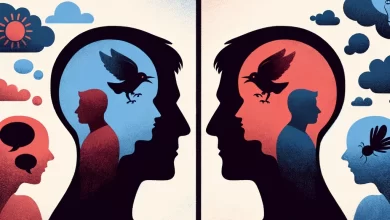Recognizing Signs of Depression: Key Symptoms
Depression, also known as major depressive disorder, is a common and serious mood disorder that affects a person’s thoughts, feelings, and daily activities. But how do you know if what you’re experiencing is depression? Is it just a passing sadness or something more? Let’s delve into the key symptoms that can help you recognize the signs of depression and seek the support you need.
Key Takeaways:
- Depression is a common and serious mood disorder that impacts a person’s thoughts, feelings, and daily activities.
- Recognizing the signs of depression is crucial for seeking appropriate support and treatment.
- Key symptoms of depression include persistent sadness, loss of interest, fatigue, difficulty concentrating, changes in appetite or weight, sleep disturbances, physical aches or pains, feelings of guilt or worthlessness, and thoughts of death or suicide.
- Not everyone with depression will experience all of these symptoms, and symptoms can vary in severity.
- It’s important to seek help from a healthcare professional if you’re experiencing symptoms of depression.
What is Depression?
Depression is a mood disorder characterized by severe symptoms that impact a person’s emotions, thoughts, and daily activities. It is also referred to as major depressive disorder or clinical depression.
People with depression experience a range of symptoms including:
- Persistent feelings of sadness
- Loss of interest or pleasure
- Fatigue or lack of energy
- Difficulty concentrating
- Changes in appetite or weight
- Sleep disturbances
- Physical aches or pains
- Feelings of guilt or worthlessness
- Thoughts of death or suicide
Depression can be caused by a combination of genetic, biological, environmental, and psychological factors. It is important to note that everyone’s experience with depression is unique, and symptoms can vary in severity.
Depression is a serious condition that can significantly impact a person’s quality of life. It is important for individuals experiencing symptoms of depression to seek help from a healthcare professional for an accurate diagnosis and appropriate treatment options.
Who gets Depression?
Depression is a mental health condition that can affect individuals from all walks of life, regardless of their age, gender, race, or socioeconomic status. However, certain risk factors can increase the likelihood of developing depression. These risk factors include:
- A family history of depression
- Personal or family history of other mental health disorders
- Experiencing traumatic or stressful life events
- Chronic medical conditions
- Certain medications
- Substance abuse
- A lack of social support
Research has also shown that depression rates can vary among different demographic groups. Here are some examples:
American Indians and Alaska Natives: This demographic group has been found to experience higher rates of depression.
Demographics of Depression: A Comparative Analysis
| Demographic Group | Depression Rates |
|---|---|
| American Indians and Alaska Natives | Higher rates |
| Other racial and ethnic groups | Varying rates |
These findings emphasize the importance of considering demographic factors when addressing depression. By recognizing the unique challenges faced by different groups, healthcare professionals can provide tailored support and treatment options.
Signs and Symptoms of Depression
Depression is a complex mental health condition that can affect individuals in different ways. While symptoms can vary from person to person, there are common signs to look out for that may indicate the presence of depression. It’s important to understand these signs and symptoms in order to recognize and address this condition effectively.
Common Indicators of Depression
Some of the key signs and symptoms of depression include:
- Persistent sadness
- Feelings of hopelessness or worthlessness
- Irritability or restlessness
- Loss of interest or pleasure in activities
- Fatigue or lack of energy
- Difficulty concentrating or making decisions
- Changes in appetite or weight
- Sleep disturbances
- Physical symptoms such as headaches or stomachaches
- Thoughts of death or suicide
It’s important to note that not everyone with depression will experience all of these symptoms. Additionally, the severity of symptoms can vary from mild to severe. If you or someone you know is exhibiting these signs, it may be an indication of depression and seeking professional help is advised.
It’s crucial to pay attention to these signs and symptoms of depression as they can impact an individual’s overall well-being and quality of life.
Depression in Different Groups
Depression is a complex mental health condition that can manifest differently in different groups. Understanding how depression presents itself in various demographics is crucial for providing effective support and treatment. Let’s explore how depression can vary among men, women, and different racial and ethnic groups.
Depression in Men
Depression in men may exhibit unique symptoms and behaviors. While men may experience feelings of sadness, they are more likely to demonstrate irritability, anger, or escapist behavior. Additionally, substance abuse or engaging in risky behaviors can be signs of depression in men. It is essential to recognize these atypical manifestations to ensure accurate diagnosis and appropriate treatment.
Depression in Women
Women are more likely to experience symptoms of depression that align with traditional understanding, such as sadness or feelings of worthlessness. It is crucial to acknowledge that women are not only more prone to depression but also more likely to seek treatment for it. This highlights the importance of promoting mental health awareness and destigmatizing seeking help among women.
Depression in Different Racial and Ethnic Groups
Depression rates can vary significantly among different racial and ethnic groups, influenced by several factors. Socioeconomic status, cultural norms, and access to healthcare all play a role in the prevalence and management of depression. It is essential to address these disparities and ensure equitable mental health support for all communities.
| Racial/Ethnic Group | Depression Prevalence (%) |
|---|---|
| American Indian/Alaska Native | X% |
| African American | Y% |
| Hispanic/Latinx | Z% |
| Asian/Pacific Islander | A% |
Note: Data provided in the table is for illustrative purposes only and may not reflect the most current statistics.
Recognizing the diverse ways depression can manifest in different groups is essential for accurate identification and effective treatment. By understanding the various presentations of depression in men, women, and different racial and ethnic groups, healthcare professionals can provide tailored support and promote mental wellness.
Seeking Help and Treatment for Depression
Depression is a treatable condition, and there are various options available for managing and treating depression. Seeking help from a healthcare professional is crucial for individuals experiencing symptoms of depression in order to receive an accurate diagnosis and appropriate treatment options.
Potential Treatment Options
There are several different treatment options available for depression, depending on the severity of symptoms and individual needs. These options may include:
- Psychotherapy: Psychotherapy, also known as talk therapy, involves meeting with a mental health professional to explore and address the underlying causes of depression. Cognitive-behavioral therapy and interpersonal therapy are commonly used types of psychotherapy that have been proven effective in treating depression.
- Medication: Antidepressant medications can help balance the chemicals in the brain that are associated with mood regulation. These medications are usually prescribed by a psychiatrist or primary care physician.
- Brain Stimulation Therapies: For individuals who have not responded to other treatment options, brain stimulation therapies such as electroconvulsive therapy (ECT) or transcranial magnetic stimulation (TMS) may be considered.
- Lifestyle Changes: Making certain changes to one’s lifestyle can also be beneficial in managing and treating depression. This may include maintaining a healthy diet, engaging in regular exercise, establishing a consistent sleep schedule, and practicing self-care activities that promote relaxation and stress reduction.
It’s important to note that the most effective treatment option for depression may vary from person to person. It is often a combination of different approaches that provide the best results.
Seeking Help
If you or someone you know is experiencing symptoms of depression, it’s crucial to seek help from a healthcare professional. Initiating a conversation with a trusted doctor, therapist, or counselor can provide support, guidance, and access to appropriate treatment options. This may include a referral to a mental health specialist, such as a psychiatrist or psychologist, who can provide specialized care for depression.
“Seeking help for depression is a courageous and important step towards regaining control of your mental health and well-being. Remember, you don’t have to face it alone.”
Many healthcare providers offer telehealth services, allowing individuals to receive therapy or medication management appointments remotely. This can be particularly helpful for those who may have difficulty accessing in-person appointments due to location, transportation, or other barriers. Additionally, there are helplines and online resources available for immediate support, such as the National Suicide Prevention Lifeline.
Availability of Treatment
It’s crucial to remember that mental health support and treatment for depression is available and accessible. While there may be disparities in access to mental health services, efforts are being made to increase availability and reduce barriers to treatment for all individuals.
If you or someone you know is in immediate danger or experiencing a mental health crisis, it’s important to call emergency services or go to the nearest emergency room for immediate assistance.
Comparison of Depression Treatment Options
| Treatment Option | Description | Pros | Cons |
|---|---|---|---|
| Psychotherapy | Talk therapy with a mental health professional to address underlying causes of depression. | – Provides a safe space to explore emotions and develop coping strategies – Can be effective in managing symptoms long-term |
– May require multiple sessions over an extended period of time – Can be costly depending on insurance coverage |
| Medication | Prescription medications that help balance brain chemicals associated with mood regulation. | – Can provide quick relief of symptoms – Can be combined with other treatment approaches |
– May have side effects – Requires close monitoring and adjustment by a healthcare professional |
| Brain Stimulation Therapies | Procedures that involve stimulating specific areas of the brain to alleviate symptoms of depression. | – Can be effective for individuals who have not responded to other treatments – May provide long-lasting relief |
– Requires specialized equipment and expertise – May have potential risks and side effects |
| Lifestyle Changes | Implementing healthy habits, such as exercise, diet, and self-care, to improve overall well-being. | – Natural and sustainable approach to managing depression – Can have positive effects on overall health |
– May require significant effort and commitment – Results may vary depending on individual circumstances |
Depression and Suicide
Depression is a mental health condition that can be associated with an increased risk of suicide. Understanding the warning signs of suicide is crucial in identifying individuals who may be at risk and providing them with the support they need.
Warning Signs of Suicide
There are several warning signs that may indicate someone is at risk for suicide. These signs can vary, but it’s important to be aware of them:
- Talking or Writing about Death: Individuals who express thoughts of death, dying, or wanting to end their life may be at risk for suicide.
- Giving Away Belongings: People who start giving away their possessions or making arrangements for after their death may be exhibiting warning signs of suicide.
- Withdrawing from Social Activities: Individuals who suddenly withdraw from their usual social engagements and isolate themselves from friends and family may be in need of help.
- Sudden Improvement in Mood: Some individuals who have been experiencing depression and then display a sudden improvement in mood may be at higher risk for suicide, as this could indicate they have made a decision to end their life.
- Previous Suicide Attempts: Individuals who have previously attempted suicide are at an increased risk and should be closely monitored for any signs of suicidal thoughts or behavior.
If you believe that you or someone you know is in immediate danger, it’s crucial to call emergency services right away. Suicide is a serious matter that requires prompt attention and intervention.
For individuals struggling with thoughts of suicide, it’s important to seek help from mental health services or helplines. These services can provide the necessary support, guidance, and resources to assist individuals in their time of need.
| Helpline | Phone Number |
|---|---|
| National Suicide Prevention Lifeline (United States) | 1-800-273-TALK (1-800-273-8255) |
| Samaritans (United Kingdom) | 116 123 |
| Beyondblue (Australia) | 1300 22 4636 |
Remember, reaching out for help is a sign of strength. Suicide is preventable, and by recognizing the warning signs and providing support, we can make a difference in the lives of those struggling with depression and thoughts of suicide.
Recognizing Depression in Different Communities
Depression can have a profound impact on individuals from all communities. However, it’s important to acknowledge that recognizing and addressing depression in certain communities can present unique challenges and barriers. Factors such as stigma, cultural beliefs, limited access to healthcare, discrimination, and systemic inequalities can greatly influence how depression is experienced and expressed.
For healthcare professionals, it is essential to have a deep understanding of the cultural and social factors that can impact mental health within different communities. This knowledge allows them to provide culturally sensitive and appropriate support and treatment to those in need.
Depression in communities of color is an area of particular concern. Research has shown that individuals from these communities often face disproportionate rates of depression and decreased access to mental health resources. To address this disparity, it is vital to promote awareness and education about depression, while also working to reduce the stigma associated with mental health within these communities.
Depression in marginalized groups is another important aspect to consider. Marginalized groups, such as LGBTQ+ individuals, refugees, and those experiencing homelessness, often face additional challenges when it comes to recognizing and addressing depression. These challenges can include higher levels of discrimination, limited social support networks, and inadequate access to mental healthcare.
“Understanding the unique experiences and needs of different communities is crucial in providing effective mental health support. By addressing the specific challenges faced by marginalized groups and communities of color, we can work towards creating a more inclusive and equitable mental healthcare system.” – Dr. Jane Simmons, Mental Health Advocate
Breaking Down Barriers
To effectively recognize and address depression in different communities, it is necessary to break down the barriers that contribute to the disparities in mental healthcare. This can involve:
- Promoting culturally competent training for healthcare professionals to better understand the diverse backgrounds and experiences of their patients.
- Increasing access to mental health resources and services in underserved communities.
- Fostering open conversations about mental health to reduce stigma and encourage help-seeking behaviors.
The Importance of Community Support
Community support plays a crucial role in recognizing and addressing depression in different communities. By fostering supportive environments, promoting mental health education, and providing resources, communities can empower individuals to seek help and access appropriate treatment.
The CDC offers valuable information and resources for understanding and addressing depression in all communities. By working together, we can create a society that supports the mental health and well-being of every individual, regardless of their background or community.
Conclusion
Recognizing the signs of depression is vital in addressing this prevalent and impactful mental health issue. Depression can manifest differently in individuals from various demographics and backgrounds, making it crucial to be aware of the diverse ways it can present itself. Seeking professional help and accessing appropriate treatment options are pivotal in managing and overcoming depression.
It is imperative for society as a whole to promote awareness, reduce stigma, and provide strong support systems for individuals who are struggling with depression. By creating a culture of understanding and empathy, we can cultivate an environment that encourages individuals to seek the help they need.
If you or someone you know is experiencing symptoms of depression, it is essential to reach out to a healthcare professional. To learn more about depression and its effects, you can refer to this informative article from the National Center for Biotechnology Information (source). Together, we can work towards a society that recognizes the signs of depression and offers the necessary support to improve mental well-being.






